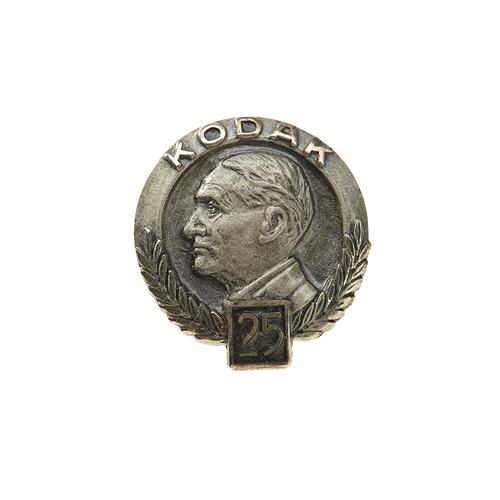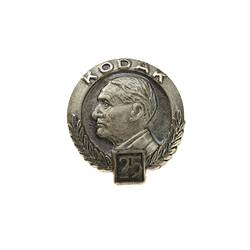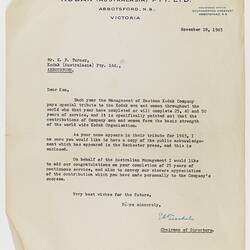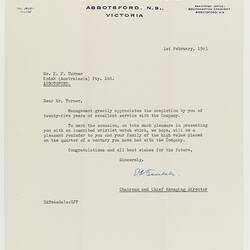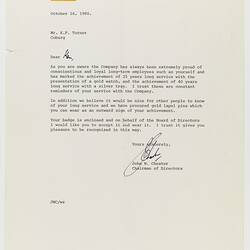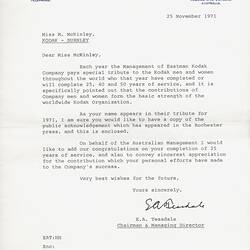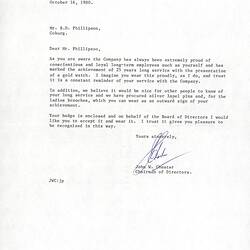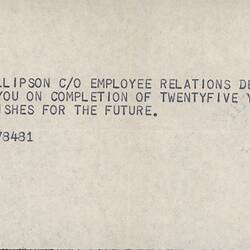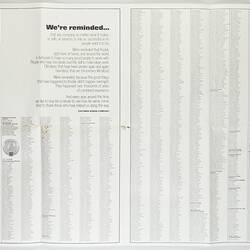Eastman Kodak Company and its subsidiary Kodak Australasia Pty Ltd were generous in acknowledging staff loyalty and long service.Their recognition of long service stemmed from the paternal management philosophies of George Eastman and Thomas Baker, the founders of Eastman Kodak Company and Kodak Australasia respectively. Both Baker and Eastman were at the forefront of industry standards when it came to staff benefits, and they cultivated a family-like company culture right from the beginnings of their businesses in the late 19th century.
Already a well-known benefactor, when Thomas Baker died in 1928 he generously left a monetary gift to all of his employees in his will, specifically singling out those who had been with the company for eight years or more for substantial gifts. A more formal system of long service recognition for Australian employees was later provided by Kodak - for those who had served for 25, 40 and 50 years.
When determining long service, the worldwide employment of Kodak employees was counted. Consequently, staff who had transferred to Kodak Australasia Pty Ltd from other subsidiaries (such as Kodak Limited in England) were recognised for the whole of their service, not just the time they had spent at Kodak Australasia Pty Ltd.
Kodak, like many companies during the 20th century, had high retention rates for staff. By 1971 the number of employees at Kodak Australasia who had completed 25 years of continuous service was 162. An additional sixty-four employees had been honoured for 40 years of service, and six employees were rewarded for 50 years service.
From at least the 1970s onwards, staff employed for 25 years received an inscribed gold watch. Employees with 40 or 50 years employment were awarded an engraved silver tray and had their names recorded by Eastman Kodak in Rochester. It is interesting to note that Kodak's care for their employees extended to awarding blind staff a braille version of the watch commemorating 25 years service.
In 1978 Kodak Australasia began to provide celebratory dinners for long service award recipients. John Chester, former Chief Executive Officer, is reported as saying that the dinners were a way for long service employees to be 'thanked by the company, to say thanks to the company [themselves] and to meet with each other'. The dinners continued well into the 1990s, while the high numbers of long service employees led the editors of the Kodakery newsletter to begin a special supplement dedicated to the topic.
By 1980 a bracelet or brooch for women and a lapel pin for men, featuring a portrait of George Eastman, were also presented to staff celebrating long service, as an 'outward sign' of their achievement. A silver version was awarded for 25 years service while a gold edition was presented to those celebrating 40 years long service. These were also offered to eligible staff who had retired before January 1979.
Over time there appears to have been a greater element of personal choice in the long service gift awarded. For example, Museums Victoria holds a lapel pin that was awarded to a female staff member rather than the traditional bracelet or brooch. By the 1980s staff with 25 years long service were able to choose between a gold watch, cutlery set, mantel clock, silver service or decanter set. Then by the 1990s the gifting process appears to have become even more informal, with one former employee recalling that they were given a budget and sent to choose their own 25 years' service gift from a local jewellery shop.
As well as Kodak Australasia's own recognition of staff, the parent company Eastman Kodak Company also acknowledged the long service of employees in its Australian subsidiary. Eastman Kodak sent congratulatory telegrams to staff, two examples of which are held by Museums Victoria. They also circulated an annual worldwide tribute listing of all those employees who had reached 25, 40 or 50 years of service. Museums Victoria holds an example of one of these global listings, presented to former Kodak employee Marie de Camara, nee McKinley, for her 25 years long service.
The high number of employees who were eligible for recognition was considered a mark of job satisfaction amongst staff. Former Kodak Australasia CEO John Chester was reported as saying that staff should feel 'pleasure' and 'pride' for the part they played in the company's affairs through their long service. He considered this especially important considering the relative unimportance that was starting to be placed on long service in the Australian workforce from the 1970s onwards. However, despite this sentiment, as Kodak Australasia Pty Ltd went into decline in the 1990s before finally closing in 2004, the numbers of staff eligible for long service recognition gradually dwindled.
Museums Victoria now holds a number of objects relating to the long service of Kodak Australasia employees, which former staff have generously donated to the collection, including 25 year lapel pins, letters of recognition, telegrams and a 40 year silver service tray.
References
'Australian Kodakery', No 1, Jul 1968, p. 4 (HT 27767)
'Australian Kodakery', No 24, Apr 1971, p. 1 (HT 35723)
'Australian Kodakery', No 26, Jun 1971, p. 3 (HT 35725)
'Australian Kodakery', No 38, Aug 1972, p. 6 (HT 35748)
'Australian Kodakery', No 95, Oct 1978, p. 4 (HT 35937)
'Australian Kodakery', No 114, May 1980, p. 2 (HT 35958)
'Australian Kodakery', No 117, Sep 1980, p. 4 (HT 35961)
'LEGACIES TO EMPLOYEES'. The Maitland Daily Mercury (NSW: 1894-1939) 20 April 1929: 5. Web. 3 Oct 2018, http://nla.gov.au/nla.news-article127763887
'Retiree Newsletter', May 1983. No. 4. Supplement to 'Australian Kodakery', No 147, May 1983, p. 1
HT 48027, Letter - John Chester to Ken Turner, Re Kodak Australasia Long Service Lapel Pin, Coburg, 16 Oct 1980.
More Information
-
Keywords
-
Authors
-
Article types
